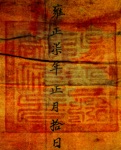A Chinese Qing dynasty silk edict scroll by the Emperor Yongzheng (1722-35)
The document written in both Chinese and Manchi script (derived from cursive Mongolian) commending Zhao Yi 趙嶧 of Youyu County in Shanxi as father, for raising and educating the famous scholar, poet and court official Zhao Zhongyuan, awarding Zhao Yi the title of 'Gentleman for Good Service' (修職郎) and 'Instructor' (教諭) for Youyu County and praising Li Shude 李淑德 (referred to in the text as Li Shufan (李淑範) as wife and mother awarding her the title of 'Child Nurturess of the 8th Rank' (八品孺人). Their son Zhao Zhongyuan 趙中元 (1702-1750) was 27 at the time as the edict was written in 1729 'the 10th day of the 1st month of the 7th year of the Yongzheng era'. The scroll may be the original of a later document issued by the Jiaqing Emperor in the collection of Yunju Temple near Beijing.
Here my summary translation of a Chinese visitor's account in 2006 of the later scroll at Yunju Temple:
On this courtyard level we visited from right to left, the first pavilion is the Heritage Collection and first saw the cultural relics and the Qing Dynasty Jiaqing Emperor’s edict. This yellow damask edict part of a collection of edicts from Xidi village, Anhui, is written in Manchu and Chinese languages. It mainly describes the Jiaqing Emperor’s recognition and reward of Zhao Yi as the father of Zhao Zhongyuan, Qing government official of Shuoping Prefecture, Youyu County, Shanxi as an honest and loyal official and praises Zao Yi’s wife Madam Li as a virtuous wife and mother...
There are two large faded seal imprints in the centre of the scroll with the date written over them in Chinese and Manchu which read 'Yang Ping Zhi Du Gong Yin' 阳平治都功印. The seal was first created in the Eastern Han Dynasty by Zhao Daoling, regarded as the founder of Wudoumi Daoism and honored as 'Celestial Master Zhang'. At the ends are white woodblock stamps with double dragons with Chinese seal script characters and Manchu script between the dragons. The scroll is 150cm long and 30cm wide and written on finely woven imperial yellow silk with a paper lining behind. My thanks to Andrew West for his help with transcribing the Chinese characters, translation and for finding the reference to the Yunju Temple scroll. For a fuller description of the scroll see my Blogspot post HERE.
Yang Ping Zhi Du Gong Yin' 阳平治都功印
In 2010 the Yongzheng Emperor’s court chaozhu pearl necklace Buddhist rosary shown in his official portrait sold for a staggering $8.7 million at Sotheby’s Hong Kong, a world record. See the last three photos below. For a very interesting article on the chaozhu see: http://www.internetstones.com/emperor-yongzheng-yinzhen-ceremonial-eastern-pearl-court-necklace-chaozhu.html
For a snapshot of Chinese history, 1929 was a very busy year for the Yongzheng Emperor, who was a hands-on ruler. Here are a few things he was involved with in that year: The Grand Council was established in 1729; 'with Lhasa and Kham under Qing control, in 1729 Yongzheng began financial and military preparations for an ambitious campaign against the Zunghar empire, a campaign that would take several decades and another emperor to complete’ 1. the first edict against the sale and smoking of opium was issued, Suzhou textile workers went on strike for better wages, he was personally involved in some important developments in ceramics production and tea growing. In relation to Shanxi he made it an official province/county 1729 and there was an edict against the 'Gathering of crowds through the spreading of evil rumours in Zezhou, Shanxi Province'. The Bureau of Instruction (Office of Music?) was renamed ’the Bureau of Harmonious Sounds' (Heshengshu) in 1729 and the Emperor issued an edict in relation to hereditary court musicians living in Shanxi, whose profession was associated with prostitution and whose ancestors had sided against an earlier emperor, allowing them to pursue a more respectable profession.
And in relation to the Emperor Yongzheng and the famous martial arts Master Gan, a fun story:
Master Gan versus the Evil Emperor - the Sequel 2.
Emperor Yongzheng summoned Master Gan soon after he took the throne. Yongzheng still wanted to enlist Gan as a bodyguard and Master Gan could not refuse an imperial invite. Besides, he thought he could learn something about the inner circle of the palace for the Ming resistance. So he went, but he found the palace too well guarded for him to look around. The emperor looked at Gan's slight build with contempt and asked, "What skill do you have?" Master Gan said, "Your subject can be a light as a sparrow or as heavy as a stone." Yongzheng ordered Gan to demonstrate. Master Gan focused his qi and then leaped up to perch on a flower bush. Yongzheng was delighted and exclaimed, "How light he is!" Before the words left his lips, Gan jumped down and his legs sank into the tiled floor up to his knees. "Supernatural!" cheered the emperor and he immediately ordered that Master Gan be rewarded. Gan quickly found an excuse then escaped the palace.
Emperor Yongzheng never let go of Master Gan after that. In 1729, the seventh year of his reign, Yongzheng had Master Gan arrested by Qing officials. More than 100 others, many of who were also martial arts masters, were taken into custody in connection to a secret anti-Qing religious sect, led by the Monk Yi Nian. Like many such secret societies of China's turbulent history, Monk Yi Nian's followers espoused a doctrine of mysticism and martial arts with an undertone of rebellion. Such movements have always threatened the governments of China, so they are crushed quickly and mercilessly, even to this day.
Footnotes: 1. Collaboration and Resistance on the Southwest Frontier: Early Eighteenth-Century Qing Expansion on Two Fronts John Herman, 2014


